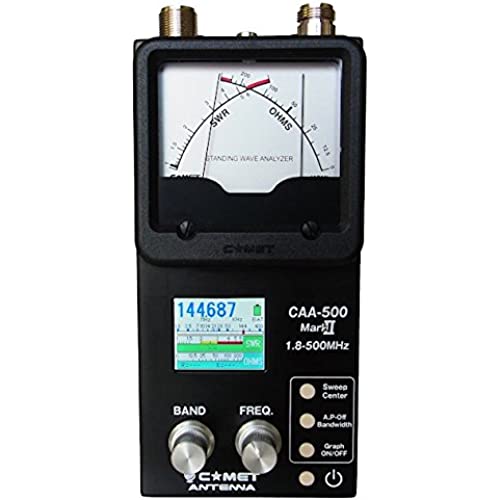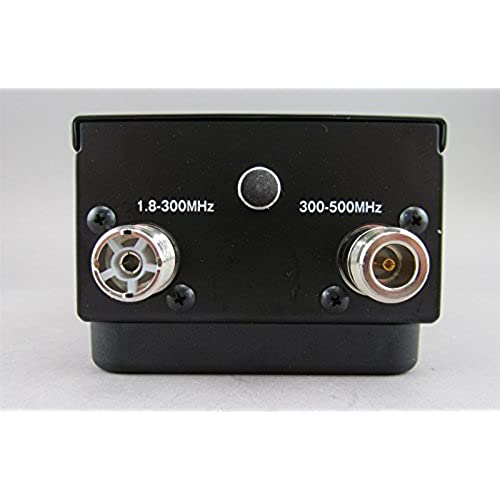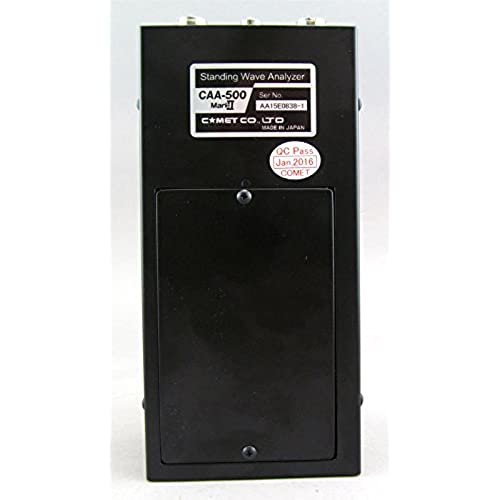





Comet Original CAA-500 Mark II Standing Wave Analyzer 1.8-500MHz SWR & Impedance Simultaneously
-

Larry
> 24 hourThe Comet CAA-500M 2 .Works great showed me the problems that I had. Now I know what needs to be fixed. Larry KD8ULC
-

Michael T. Koralewski
> 24 hourExactly what I needed!
-

JV
> 24 hourWell worth the money. It came damaged in shipping and return and replacement was easy/Peazy. Thanks Amazon
-

Rock Dubois
> 24 hourMy concern was being able to see the display in bright sun light. No problem and having the analog meter is a great help. Highly recommend.
-

Christopher Suleske
> 24 hourEasy to use. I think I read the manual first, but there was really no need. Its 95% intuitive for a ham whos experienced with HF. Id give it 5 stars, but Im dinging it 1 star for: 1. not including a case of any kind (got a nice hard-sided one for $25, see below) 2. the fact it should have a rechargeable LiPo battery included 3. that it doesnt have a USB port for exporting data to a computer for sharing with the world 4. that the 300-500 Mhz range is routed to an N style connector. I understand theyre less lossy at UHF, but practically how many of us use them? At least include an N to SO-239 adapter (which I ended up buying) This is probably the top of the line manual analyzer out there. If youre the sort of ham who thinks he knows better than a computer, this ones for you. You create the graphs either by auto sweeping a range or manually doing so. If you want to record the readings, youll have to do something like what I do: snap a photo of the display with my phone. Not elegant, but it works. Im sure there the Mark III will be out next year with a USB port. After using MFJ units, this is a definite step-up. It seems like a pro-grade item. I found the perfect hard case on Amazon. Only $25 and made in USA. Search for Seahorse 230 Medium Tactical Case with Foam, Black. It has room for the Comet, manual, and several adapters.
-

Carlos Pulgar
> 24 hourExcellent construction typical Japanese good quality and good materials... good looks and fine finish... easy single knob band selection and easy to read multi function color screen and simultaneous SWR and ohms cross middle gauge.. Unfortunately this unit Don’t do coaxial cable testing.. I wish Comet include cable testing functionality in future models.
-

Alan J. Cunningham
> 24 hourI needed to tweak three VHF/UHF antennas (LPDA beam, dis-cone & 50 MHz loop). This device makes it very simple to sweep the antennas. The dis-cone covered 50-500+ MHz and the Comet made it a snap to check it out. Recommended.
-

Paul C.
> 24 hourIve likely tuned hundreds of antennas SWR over my year using the old method of checking each end of a band and adjusting a bit to center the dip. I looked long and hard at the cheap $30 and $40 meters and Ive had so much bad luck with them I thought about getting something better ... and ended up getting WAY BETTER! The meter is so simple to use. You select the correct output 2M and above or 2M and below and connect the antenna up to the meter. Twist one knob to select the band and the other to pick the frequency inside that band and the cross needles indicate the SWR and the impedance of the antenna. Press a button and the meter will sweep the band displaying the slope on the small color screen. With HF bands this is very handy to see just what the SWR is across a wide number of frequencies. Tuning dual and tri-band VHF/UHF antennas on my Jeep was simple. The only thing missing is a USB port to off load screen captures of the SWR plots.
-

orhanboyaci
> 24 hourThankyou
-

HDthumper
> 24 hourPurchased this to replace a defunct MFJ UHF unit. This makes the MFJ look and feel like a toy. Much easier to use and built like a brick. Typical High Quality Japan construction. The MFJ gave good service, but there is no comparison in build quality. The graphing is nice, if a little small. Only gripe is I wish I could download the graphs. Comes with a charging cable if you use NiMh but you have to supply the Power source. Not an issue for me. There is an SO-239 for use up to 300 MHz, and an N connector for 300 to 500 MHz. I always carry adaptors for both connectors as you never know what you will find in a remote location. I just leave them threaded on the unit.
